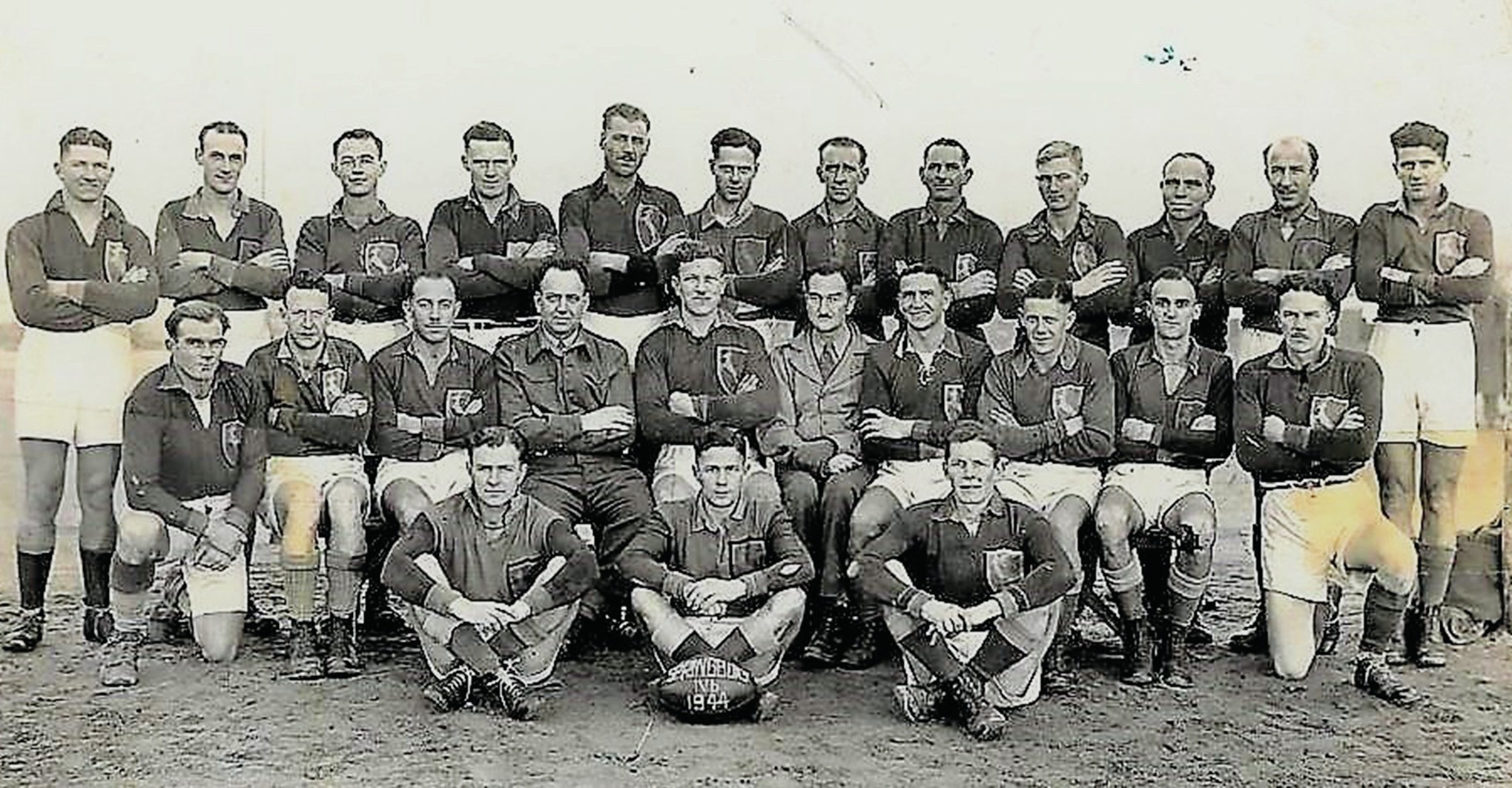Wartime ‘Springboks’ were simply unbeatable

Brendan Gallagher delves into some of rugby‘s most enduring images, their story and why they are still so impactful
Iconic Rugby Pictures:
PART 85
South African POWs reign supreme at Stalag 1Vb Spring 1944
What’s happening here?
It’s spring 1944 at the Stalag 1Vb Prisoner of War camp in Muhlburg, one of the biggest and harshest in Nazi Germany which at one stage imprisoned 21,000 men. A 700-strong South African contingent, mostly captured in North Africa, have formed a rugby team to challenge an ANZAC XV of Kiwis and Aussies. A large Welsh contingent also took up the challenge and played the “Boks” in two “Tests” while later South Africa were to play a combined team from Scotland, Ireland and England and also took on the Rest of the World, ie a select team from all the other nations. The story is surely an epic film waiting to be made.
Back row, left to right: J Oakley, I Van Huyssteen, Kaplan, Timm, GJ Coetzee, N Hinds, B Wessels, CF Heydenreich, H B Youngleson, AL Foster, EA Chapman, JV Rall. Middle row: AJ Fabricius, M Moore, G Ackermann, Major Ochse (medical officer), BS ‘Fiks’ van der Merwe (captain), D Katzeff, CA van der Westhuizen, JHB Ritchie, A Hultzer, J Zietsman. Front row: DJ Marais, R Hinds, EP Sephton.
What’s is the story behind the picture?
The South Africans arrived in the autumn of 1943 and contained many decent players. At least eight had appeared in provincial rugby games while full-back Gus Ackermann had been tipped for Springbok honours on the eve of war. Skipper Fiks van der Merwve, from Northern Transvaal, was to skipper the Blue Bulls to Currie Cup success in 1946 and was capped against the 1949 All Blacks although a badly broken ankle in that game brought his career to an end.
Initially the South Africans instigated an almost daily inter-hut league and at one stage there were 32 huts split into four divisions. The prisoners could blow off steam for an hour or more every day and keep fit while the Germans knew exactly what the more active prisoners were up to. Well that was the theory. The natural extension of this was a series of challenge international matches and they were taken very seriously, the South Africans even held a trial match to pick their starting fifteen.
“This is all about roaring defiance in the face of adversity, mateship and team work to keep going”
National pride was at stake and much ingenuity went into the preparation and offered up a chance for the non-sportsmen to get involved and demonstrate their skills and commitment.
The Red Cross had delivered a consignment of balls and whistles and also a large number of long sleeved white vests and the latter were transformed to green jerseys by using the dye from the uniforms of Russian or Italian soldiers in camp. For the gold collars, cuffs and sock tops the camp medics dissolved a quantity of the large stockpile of anti-malaria tablets they possessed while former tailors devised and sewed in a Springbok emblem.
For the boots a number of former cobblers in camp stepped forward. The rugby boots were basically wellworn regulation Army boots with the heels removed. From those heels six studs were fashioned and attached to the soles of boots. And for laces the strong twine used to tie the various Red Cross parcels served very nicely. The troops’ cigarette rations were used to bribe some of the German guards for bits and pieces – mostly shorts – while ahead of the game those not playing volunteered some of their meagre rations for those who were participating.
What happened next.?
A series of hotly contested games ensued watched by crowds of 2,500 or more. Between April and June 1944 the Boks defeated the ANZACS 21-0, the combined England/Ireland/Scotland team 14-3, Wales 14-3 and the Rest of the World 9-0. Finally the Welsh fancied another pop at them and amid reports of an outbreak of illness in the South African huts the Boks were a diminished team but still scraped a 3-0 win.
After that the Tests appear to have stopped. Conditions in the camp were deteriorating and there had been a number of foiled escape attempts. An underground tunnel system was discovered while a number of prisoners were gunned down while attempting to climb the barbed wire perimeter.
Why is the picture iconic?
This is all about roaring defiance in the face of adversity, mateship and team work to keep going in the most difficult of circumstances and trying to keep in contact with normality. Stalag 1VB was a tough camp and the journey there was miserable and bloody for many of those involved. They had arrived from the killing fields of Europe and North Africa and already they had seen friends and colleagues blown up in front of them. Many of those faces staring out at you are hungry and malnourished and in some cases they are desperately clinging on to their sanity. Captive servicemen died at Stalag 1VB on a daily basis from TB, typhus, suicide or just sheer exhaustion. Some had already tried to escape, others were to launch future attempts.
Forming a rugby team was part of the survival process, a game they all loved which fired up memories of home.
As with any team everybody did what they could, the stronger and more resilient individuals kept an eye on those who were struggling. The banter carried everybody along. The victories were shared, enjoyed and dissected for months on end.
Footnote: Not only were the “Test” matches a success but two underground newspapers at the camp written on old wallpaper and handed around from hut to hut – the Observer and the 5-0 News – carried reports and articles.